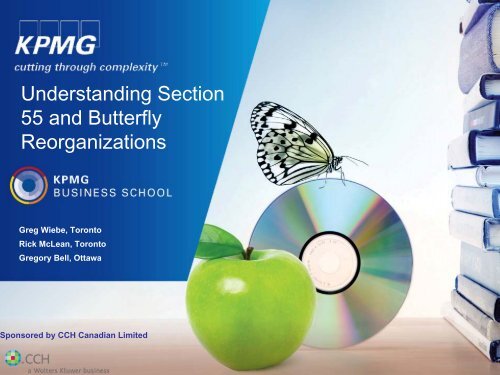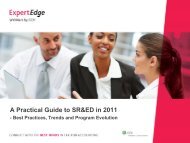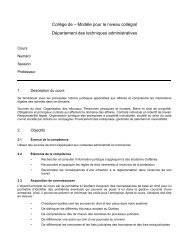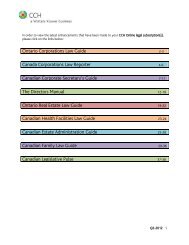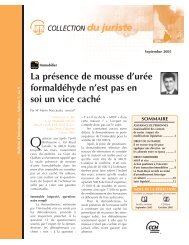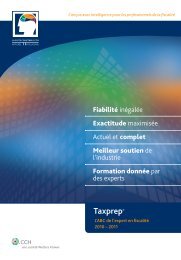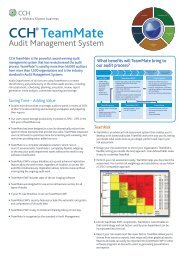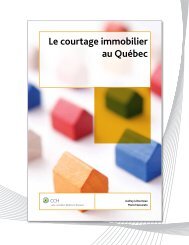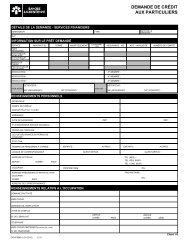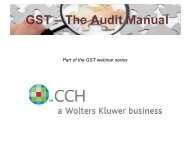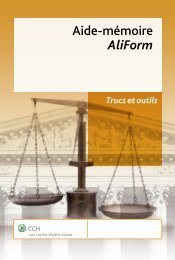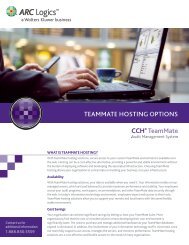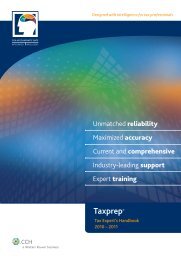Exceptions from Subsection 55(2) - CCH Canadian
Exceptions from Subsection 55(2) - CCH Canadian
Exceptions from Subsection 55(2) - CCH Canadian
- No tags were found...
Create successful ePaper yourself
Turn your PDF publications into a flip-book with our unique Google optimized e-Paper software.
Understanding Section<strong>55</strong> and ButterflyReorganizationsGreg Wiebe, TorontoRick McLean, TorontoGregory Bell, Ottawaponsored by <strong>CCH</strong> <strong>Canadian</strong> Limited
Greg Wiebe<strong>Canadian</strong> ManagingPartner - TaxKPMG LLP© 2010 KPMG LLP, a <strong>Canadian</strong> limited liability partnership and a member firm of the KPMG network of independent member firms affiliated withKPMG International Cooperative (“KPMG International”), a Swiss entity. All rights reserved. Printed in Canada.
Agenda• Overview of <strong>Subsection</strong> <strong>55</strong>(2)• <strong>Exceptions</strong> <strong>from</strong> <strong>Subsection</strong> <strong>55</strong>(2)• Types of Butterflies• Qualifying for the Exemption• Butterfly Denial Rules• Public Company Spin-offs• Related Issues• Wrap-up• Appendix© 2010 KPMG International Cooperative (“KPMG International”). KPMG International provides no client services and is aSwiss entity with which the independent member firms of the KPMG network are affiliated 2
Rick McLeanTax Partner - TorontoKPMG LLPGregory BellTax Partner - OttawaKPMG LLP© 2010 KPMG LLP, a <strong>Canadian</strong> limited liability partnership and a member firm of the KPMG network of independent member firms affiliated withKPMG International Cooperative (“KPMG International”), a Swiss entity. All rights reserved. Printed in Canada.
Overview of <strong>Subsection</strong> <strong>55</strong>(2)• Anti-avoidance rule• Recharacterizes dividends received by a corporation asa capital gain or proceeds of disposition• <strong>Exceptions</strong>:• safe income dividends• dividends subject to Part IV tax• dividends arising in certain “related party” transactions –paragraph <strong>55</strong>(3)(a)• dividends arising in butterfly reorganizations –paragraph <strong>55</strong>(3)(b)© 2010 KPMG International Cooperative (“KPMG International”). KPMG International provides no client services and is aSwiss entity with which the independent member firms of the KPMG network are affiliated 4
Purpose of <strong>Subsection</strong> <strong>55</strong>(2) —Example 1ShareholderVendorcoFMV 100ACB 0PUC 0UnrelatedPurchaseco• Vendorco to sellTargetco toPurchaseco• Vendorco wouldrealize capital gainof $100Targetco© 2010 KPMG International Cooperative (“KPMG International”). KPMG International provides no client services and is aSwiss entity with which the independent member firms of the KPMG network are affiliated 5
Purpose of <strong>Subsection</strong> <strong>55</strong>(2) —Example 1Div 100ShareholderVendorcoFMV 0ACB 0PUC 0TargetcoUnrelatedPurchasecoLoan 100• Purchaseco lends $100 toTargetco• Targetco pays $100dividend to Vendorco• Dividend deductibleunder subsection 112(1)• Vendorco sells Targetco toPurchaseco for $nil• “PURPOSE” of dividendwas to reduce capital gainon shares of Targetco© 2010 KPMG International Cooperative (“KPMG International”). KPMG International provides no client services and is aSwiss entity with which the independent member firms of the KPMG network are affiliated 6
Purpose of <strong>Subsection</strong> <strong>55</strong>(2) —Example 2ShareholderVendorcoUnrelatedPurchaseco• Vendorco to sell SellProperty to Purchaseco• Vendorco would realizecapital gain / income onsaleKeep propertySell propertyFMV 100ACB 0© 2010 KPMG International Cooperative (“KPMG International”). KPMG International provides no client services and is aSwiss entity with which the independent member firms of the KPMG network are affiliated 7
Purpose of <strong>Subsection</strong> <strong>55</strong>(2) —Example 2Shareholder• Vendorco transfers sellproperty to Purchaseco ontax-deferred rolloverVendorcoPrefsFMV 100ACB 0PUC 0UnrelatedPurchaseco• Purchaseco issuespreferred shares toVendorco• Purchaseco redeemspreferred shares• Deemed dividend onredemption rather thancapital gainKeep propertyS85 tax-deferredSell property• RESULT of deemeddividend was reduction ofcapital gain on preferredshares• No gain / income realized ontransfer of Sell Property© 2010 KPMG International Cooperative (“KPMG International”). KPMG International provides no client services and is aSwiss entity with which the independent member firms of the KPMG network are affiliated 8
<strong>Subsection</strong> <strong>55</strong>(2) — Resident CorporationReceives Taxable DividendWhere a corporation resident in Canada has received ataxable dividend in respect of which it is entitled to adeduction under subsections 112(1) or 112(2) or138(6)...© 2010 KPMG International Cooperative (“KPMG International”). KPMG International provides no client services and is aSwiss entity with which the independent member firms of the KPMG network are affiliated 9
<strong>Subsection</strong> <strong>55</strong>(2) —Part of a Series...as part of a transaction or event or a series oftransactions or events© 2010 KPMG International Cooperative (“KPMG International”). KPMG International provides no client services and is aSwiss entity with which the independent member firms of the KPMG network are affiliated 10
<strong>Subsection</strong> <strong>55</strong>(2) —Purpose or Results Test...one of the purposes of which (or, in the case of adividend under subsection 84(3), one of the results ofwhich) was to effect a significant reduction in theportion of the capital gain that, but for the dividend,would have been realized on a disposition at fair marketvalue of any share of capital stock immediately beforethe dividend...© 2010 KPMG International Cooperative (“KPMG International”). KPMG International provides no client services and is aSwiss entity with which the independent member firms of the KPMG network are affiliated 11
What Happens if <strong>Subsection</strong> <strong>55</strong>(2) Applies?• Not a dividend received• Proceeds of disposition if share disposed of• Deemed gain on disposition of a capital property ifshare not disposed of• Dividend payor is still considered to have paid adividend– Consider impact on tax pools such as GRIP© 2010 KPMG International Cooperative (“KPMG International”). KPMG International provides no client services and is aSwiss entity with which the independent member firms of the KPMG network are affiliated 12
<strong>Exceptions</strong> <strong>from</strong> <strong>Subsection</strong> <strong>55</strong>(2)© 2010 KPMG LLP, a <strong>Canadian</strong> limited liability partnership and a member firm of the KPMG network of independent member firms affiliated withKPMG International Cooperative (“KPMG International”), a Swiss entity. All rights reserved. Printed in Canada.
First Exception: Income Earned or Realized“Safe Income”...and that [the capital gain] could reasonably beconsidered to be attributable to anything other thanincome earned or realized by any corporation after 1971and before the safe-income determination time.© 2010 KPMG International Cooperative (“KPMG International”). KPMG International provides no client services and is aSwiss entity with which the independent member firms of the KPMG network are affiliated 14
Second Exception:Part IV Tax...subject to tax under Part IV that is not refunded as aconsequence of the payment of a dividend to acorporation when the payment is part of the series.© 2010 KPMG International Cooperative (“KPMG International”). KPMG International provides no client services and is aSwiss entity with which the independent member firms of the KPMG network are affiliated 15
Third Exception:<strong>Subsection</strong> <strong>55</strong>(3)(a) Transactions• Exemption for dividends arising in so-called relatedpartytransaction• Must satisfy all the tests in paragraph <strong>55</strong>(3)(a) toescape subsection <strong>55</strong>(2)© 2010 KPMG International Cooperative (“KPMG International”). KPMG International provides no client services and is aSwiss entity with which the independent member firms of the KPMG network are affiliated 16
Fourth Exception: Paragraph <strong>55</strong>(3)(b) ButterflyReorganizations• Divide company among its shareholders• Relies on other provisions– <strong>Subsection</strong> 85(1): Tax-deferred rollover– <strong>Subsection</strong> 84(3): Deemed dividend (not proceeds of disposition)– <strong>Subsection</strong> 112(1): Taxable dividends generally deductible bycorporate recipients• No specific rule allows non-taxable division of a company– e.g., tax-deferred wind-up rule in subsection 88(1) only applies to90%-owned subsidiaries© 2010 KPMG International Cooperative (“KPMG International”). KPMG International provides no client services and is aSwiss entity with which the independent member firms of the KPMG network are affiliated 17
Types of Butterflies© 2010 KPMG LLP, a <strong>Canadian</strong> limited liability partnership and a member firm of the KPMG network of independent member firms affiliated withKPMG International Cooperative (“KPMG International”), a Swiss entity. All rights reserved. Printed in Canada.
Types of Butterflies• Split-up• Spin-off© 2010 KPMG International Cooperative (“KPMG International”). KPMG International provides no client services and is aSwiss entity with which the independent member firms of the KPMG network are affiliated 19
Types of Butterflies — Split-up vs Spin-offBeforeA60%B40%DistributingCorp (DC)FMV $600FMV $400Opco 1 Opco 2• Shareholders A and B to implement a butterfly of Distributing Corporation(DC)• Either Spin-off or Split-up© 2010 KPMG International Cooperative (“KPMG International”). KPMG International provides no client services and is aSwiss entity with which the independent member firms of the KPMG network are affiliated 20
Split-up Butterfly —AfterABDCTransfereeFMV $600 FMV $400Opco 1 Opco 2• A split-up butterfly involves a transfer of property of the DC to one or more corporateshareholders (the Transferee Corporations)• In a split-up butterfly, a shareholder or group of shareholders takes its proportionate share of theDistributing Corporations’ assets and liabilities and exits• This is an example of a “single-wing” split-up (one Transferee)• The basic requirements for a split-up butterfly are contained in paragraph (b)(ii) of the definitionof “permitted exchange” in subsection <strong>55</strong>(1)© 2010 KPMG International Cooperative (“KPMG International”). KPMG International provides no client services and is aSwiss entity with which the independent member firms of the KPMG network are affiliated 21
Spin-off Butterfly —AfterAB60%40%40%60%DCTransfereeFMV $600 FMV $400Opco 1 Opco 2• A spin-off butterfly involves a transfer of property to one or more TransfereeCorporations owned by ALL DC shareholders in the same proportions that theyown in the DC• Basic requirements for a spin-off butterfly are contained in paragraph (b)(iii) of thedefinition of “permitted exchange” in subsection <strong>55</strong>(1)© 2010 KPMG International Cooperative (“KPMG International”). KPMG International provides no client services and is aSwiss entity with which the independent member firms of the KPMG network are affiliated 22
Spin-off Butterfly — Basic StepsBeforeShareholder(s)DCAsset 1(40% of net FMV)Asset 2(60% of net FMV)• Distributing Corporation is owned by several unrelated shareholders• Asset 1 is to be spun-off to a new corporation owned by all of theshareholders of DC© 2010 KPMG International Cooperative (“KPMG International”). KPMG International provides no client services and is aSwiss entity with which the independent member firms of the KPMG network are affiliated 23
Spin-off Butterfly — Basics StepsCreation of Transferee and Permitted ExchangeShareholder(s)60%Transferee40%DCAsset 1(40% of net FMV)Asset 2(60% of net FMV)• All DC shareholders transfer 40% of their DC shares to new corporation(“Transferee”)• The transfer of shares is called a “permitted exchange”• Rollovers available under subsection 85(1) or section 85.1© 2010 KPMG International Cooperative (“KPMG International”). KPMG International provides no client services and is aSwiss entity with which the independent member firms of the KPMG network are affiliated 24
Spin-off Butterfly — Basics StepsTransfer of Property to TC = “Distribution”100%commonShareholder(s)40% common60%commonTransfereepreferredDCAsset 1 S85 tax-deferred Asset 2• DC transfers 40% of its net assets (Asset 1) to Transferee on rollover basis• DC receives preferred shares of Transferee• The transfer of property is called the “distribution”© 2010 KPMG International Cooperative (“KPMG International”). KPMG International provides no client services and is aSwiss entity with which the independent member firms of the KPMG network are affiliated 25
Spin-off Butterfly — Basics StepsCross-cancellation of Shares Results in DividendsShareholder(s)100% 100%TransfereenotenoteDCAsset 1Asset 2• DC purchases for cancellation its common shares held by Transferee for a note• Transferee redeems its preferred shares held by DC for note• The share redemptions / purchases for cancellation are called “permitted redemptions”• The deemed dividends arising on the cross-redemptions are the dividends that are protected <strong>from</strong>subsection <strong>55</strong>(2) by the exemption in paragraph <strong>55</strong>(3)(b)© 2010 KPMG International Cooperative (“KPMG International”). KPMG International provides no client services and is aSwiss entity with which the independent member firms of the KPMG network are affiliated 26
Spin-off Butterfly — Basics StepsNotes OffsetShareholder(s)100% 100%TransfereeDCAsset 1Asset 2• The notes are set off against each other and cancelled© 2010 KPMG International Cooperative (“KPMG International”). KPMG International provides no client services and is aSwiss entity with which the independent member firms of the KPMG network are affiliated 27
Full Split-up ("Double-wing") Butterfly• All property of Distributing Corporation transferred toTransferee Corporations• Distributing Corporation is wound-up© 2010 KPMG International Cooperative (“KPMG International”). KPMG International provides no client services and is aSwiss entity with which the independent member firms of the KPMG network are affiliated 28
Full Split-up Butterfly — Basic StepsTransferee ATransferee BPrefPrefCommonCommonDCPropertyS85 transferof property• DC transfers or distributes a pro rata amount of its property toeach Transferee on rollover basis• DC receives preferred shares of each Transferee© 2010 KPMG International Cooperative (“KPMG International”). KPMG International provides no client services and is aSwiss entity with which the independent member firms of the KPMG network are affiliated 29
Full Split-up Butterfly — Basic StepsTransferee ATransferee BNoteNotePropertyPropertyDC• Each Transferee redeems its preferred shares held by DC for a note• DC winds-up and distributes notes• Deemed dividends arise on share redemptions and wind-up© 2010 KPMG International Cooperative (“KPMG International”). KPMG International provides no client services and is aSwiss entity with which the independent member firms of the KPMG network are affiliated 30
Full Split-up Butterfly — Basic StepsTransferee ATransferee BPropertyProperty© 2010 KPMG International Cooperative (“KPMG International”). KPMG International provides no client services and is aSwiss entity with which the independent member firms of the KPMG network are affiliated 31
Qualifying for the Exemption© 2010 KPMG LLP, a <strong>Canadian</strong> limited liability partnership and a member firm of the KPMG network of independent member firms affiliated withKPMG International Cooperative (“KPMG International”), a Swiss entity. All rights reserved. Printed in Canada.
Paragraph <strong>55</strong>(3)(b) — Statutory Requirements• “In the course of a reorganization”• DC makes a “distribution”• DC wound up or transferee cross-ownership eliminated• Exemption applies only to dividends <strong>from</strong> permittedredemptions or wind-up of DC© 2010 KPMG International Cooperative (“KPMG International”). KPMG International provides no client services and is aSwiss entity with which the independent member firms of the KPMG network are affiliated 33
Distribution – <strong>Subsection</strong> <strong>55</strong>(1) Definition• Definition of “distribution” requires:– the Distributing Corporation to make a pro rata distribution of– each “type of property” to– each Transferee Corporation• Pro rata based on % ownership (by value) of Distributing Corporation• Achieving a pro rata distribution is paramount to achieving a successfulbutterfly reorganization• Public company spin-off butterflies are exempt <strong>from</strong> requirement todistribute each type of property© 2010 KPMG International Cooperative (“KPMG International”). KPMG International provides no client services and is aSwiss entity with which the independent member firms of the KPMG network are affiliated 34
Pro-Rata Distribution —Types of PropertyRequirement• Each Transferee Corporation must receive its proportionate share of eachtype of property owned by the Distributing Corporation• The Act does not define “types of property”• CRA says there are three types:– cash and near cash– investment property– business property• Intended to prevent a “cashing out” of a shareholder• Without pro-rata distribution requirement, could distribute only cashproperty to a shareholder to allow the shareholder to “sell out” on a taxfreebasis© 2010 KPMG International Cooperative (“KPMG International”). KPMG International provides no client services and is aSwiss entity with which the independent member firms of the KPMG network are affiliated 35
Pro Rata Test• Gross or Net Assets– Gross – sanctioned by the Act– Net – allowed administratively• Example – Two equal shareholders– The assets of DC are two properties of the same type: property A andproperty B:FMV of property A: $1,100FMV of property B: 1,000Total liabilities: (300)Net: $1,800– Assets cannot be split on a gross basis, but could be split on a net basis byassuming $200 of liabilities with property A and $100 of liabilities withproperty B so that each transferee receives $900 of net property.© 2010 KPMG International Cooperative (“KPMG International”). KPMG International provides no client services and is aSwiss entity with which the independent member firms of the KPMG network are affiliated 36
Pro-Rata Distribution Requirement —Spin-off Butterfly ExampleShareholder(s)Transferee40%DC60%Asset 1(40% of net FMV)Asset 2(60% of net FMV)• In earlier spin-off butterfly example, Transferee became 40% shareholder of DC• DC was required to transfer or “distribute” 40% of each type of property (net ofliabilities) to Transferee© 2010 KPMG International Cooperative (“KPMG International”). KPMG International provides no client services and is aSwiss entity with which the independent member firms of the KPMG network are affiliated 37
Look-Through Concept• Property determined on a consolidated look-throughbasis• In characterizing DC’s property, it is necessary to“look through” the shares of its subsidiaries and othercorporations over which it has significant influence• Assets and liabilities of such entities effectively treatedas those of DC© 2010 KPMG International Cooperative (“KPMG International”). KPMG International provides no client services and is aSwiss entity with which the independent member firms of the KPMG network are affiliated 38
Pro-Rata Distribution Requirement —Split-up Butterfly ExampleABDCTransfereeFMV $600 FMV $400Opco 1 Opco 2• In earlier split-up butterfly example, DC was required to transfer or “distribute” 40%of each type of property (net of liabilities) to Transferee• Shares of Opco 2 must represent 40% of each type of property– Look to underlying assets / liabilities of Opco 1 and Opco 2© 2010 KPMG International Cooperative (“KPMG International”). KPMG International provides no client services and is aSwiss entity with which the independent member firms of the KPMG network are affiliated 39
Butterfly Denial Rules© 2010 KPMG LLP, a <strong>Canadian</strong> limited liability partnership and a member firm of the KPMG network of independent member firms affiliated withKPMG International Cooperative (“KPMG International”), a Swiss entity. All rights reserved. Printed in Canada.
Butterfly Denial Rules —<strong>Subsection</strong> <strong>55</strong>(3.1)• Butterfly will fail and dividends subject to subsection<strong>55</strong>(2) if:– Acquisitions of property before butterfly – prevent taxdeferredasset exchanges and “cashing out” – paragraph<strong>55</strong>(3.1)(a)– Insufficient continuity of shareholder interests – prevent“purchase butterflies” – paragraph <strong>55</strong>(3.1)(b)– Insufficient continuity of assets – maintain continuity ofinterest in underlying assets – paragraphs <strong>55</strong>(3.1)(c), (d)© 2010 KPMG International Cooperative (“KPMG International”). KPMG International provides no client services and is aSwiss entity with which the independent member firms of the KPMG network are affiliated 41
Application of Butterfly Denial Rules —Spin-off Butterfly ExampleShareholder(s)100% 100%TransfereeDCAsset 1Asset 2Paragraph <strong>55</strong>(3.1)(a) “Property Becoming Property” Rule• DC cannot acquire property in contemplation of butterfly distribution• Intended to prevent change in mix of types of property of DC• Intended to prevent parties <strong>from</strong> exchanging or “swapping” properties• <strong>Exceptions</strong> for certain related-party transfers– e.g., DC could transfer property to subsidiary of DC• Sale of property for cash or non-convertible debt before butterfly is allowed© 2010 KPMG International Cooperative (“KPMG International”). KPMG International provides no client services and is aSwiss entity with which the independent member firms of the KPMG network are affiliated 42
Application of Butterfly Denial Rules —Spin-off Butterfly ExampleShareholder(s)100% 100%TransfereeDCAsset 1Asset 2Paragraph <strong>55</strong>(3.1)(b) “Continuity of Interests” Rule• Intended to prevent “purchase butterflies”• “Specified shareholders” (generally 10%) cannot dispose of shares of DC or Transferee tounrelated persons• Acquisitions of control of DC or Transferee are not allowed• There are restrictions on acquiring shares of DC in contemplation of the butterfly© 2010 KPMG International Cooperative (“KPMG International”). KPMG International provides no client services and is aSwiss entity with which the independent member firms of the KPMG network are affiliated 43
Application of Butterfly Denial Rules —Spin-off Butterfly ExampleShareholder(s)100% 100%TransfereeDCAsset 1Asset 2<strong>Exceptions</strong> to “Continuity of Interests” Rule• "Permitted exchange” - allows for transfer of shares of DC to Transferee• "Permitted redemption” - allows for disposition of shares on cross-redemption• "Permitted acquisition“ generally to facilitate sequential butterflies• Definitions found in subsection <strong>55</strong>(1)© 2010 KPMG International Cooperative (“KPMG International”). KPMG International provides no client services and is aSwiss entity with which the independent member firms of the KPMG network are affiliated 44
Application of Butterfly Denial Rules —Spin-off Butterfly ExampleShareholder(s)100% 100%TransfereeDCAsset 1Asset 2• Paragraph <strong>55</strong>(3.1)(c) “Continuity of Assets” Rule for Transferee Corporation– Transferee is restricted <strong>from</strong> selling butterflied property• Paragraph <strong>55</strong>(3.1)(d) “Continuity of Assets” Rule for Distributing Corporation– DC is restricted <strong>from</strong> selling non-butterflied property• Rules apply if more than 10% of fair market value of property of TC or DC is sold© 2010 KPMG International Cooperative (“KPMG International”). KPMG International provides no client services and is aSwiss entity with which the independent member firms of the KPMG network are affiliated 45
Application of Butterfly Denial Rules —Spin-off Butterfly ExampleShareholder(s)100% 100%TransfereeDCAsset 1Asset 2<strong>Exceptions</strong> to “Continuity of Asset” Rules• Dispositions in ordinary course of business– Not defined• On sequential butterflies• On an amalgamation with a related corporation• Rules do not apply to dispositions of cash or debt receivable© 2010 KPMG International Cooperative (“KPMG International”). KPMG International provides no client services and is aSwiss entity with which the independent member firms of the KPMG network are affiliated 46
Public Company Spin-offs© 2010 KPMG LLP, a <strong>Canadian</strong> limited liability partnership and a member firm of the KPMG network of independent member firms affiliated withKPMG International Cooperative (“KPMG International”), a Swiss entity. All rights reserved. Printed in Canada.
Public Company Spin-off Rules• Public company spin-offs are not subject to the “types of property”requirements– “types of property” rules prevent “cashing out” transactions– not relevant in public company spin-off butterflies• Can distribute any mix of property• Only applies to spin-offs (and not split-ups)• Applies to wholly-owned subsidiaries of public companies• Distributing corporation can do another spin-off but not a split-upbutterfly within three years• Transferee cannot do any butterfly for three years© 2010 KPMG International Cooperative (“KPMG International”). KPMG International provides no client services and is aSwiss entity with which the independent member firms of the KPMG network are affiliated 48
Related Issues© 2010 KPMG LLP, a <strong>Canadian</strong> limited liability partnership and a member firm of the KPMG network of independent member firms affiliated withKPMG International Cooperative (“KPMG International”), a Swiss entity. All rights reserved. Printed in Canada.
Related Issues• Part IV tax and RDTOH• Part V1.1 tax• Eligible dividend designations• CDA elections• Acquisition of control© 2010 KPMG International Cooperative (“KPMG International”). KPMG International provides no client services and is aSwiss entity with which the independent member firms of the KPMG network are affiliated 50
This webinar is sponsored by <strong>CCH</strong> <strong>Canadian</strong> Limited.Questions?For more information, please visit www.cch.ca orcall customer Service at 1-800-268-4522.The only comprehensive referencesource on section <strong>55</strong> and butterflyreorganizations in Canada.www.cch.ca/butterflyToday’s presentersGreg Wiebe (416) 777-3271 gwiebe@kpmg.caRick McLean (416) 777-8584 rmclean@kpmg.caGregory Bell (613) 212-2800 gregorybell@kpmg.caInformation is current to September 1, 2010. The information contained herein is of a general nature and is not intended to address the circumstances of anyparticular individual or entity. Although we endeavor to provide accurate and timely information, there can be no guarantee that such information is accurate asof the date it is received or that it will continue to be accurate in the future. No one should act on such information without appropriate professional advice aftera thorough examination of the particular situation.KPMG and the KPMG logo are registered trademarks of KPMG International Cooperative (“KPMG International”), a Swiss entity.© 2010 KPMG LLP, a <strong>Canadian</strong> limited liability partnership and a member firm of the KPMG network of independent member firms affiliated withKPMG International Cooperative (“KPMG International”), a Swiss entity. All rights reserved. Printed in Canada.


